By the Community, For the Community: New Startup Accelerator Backs Locally-Led Climate Solutions
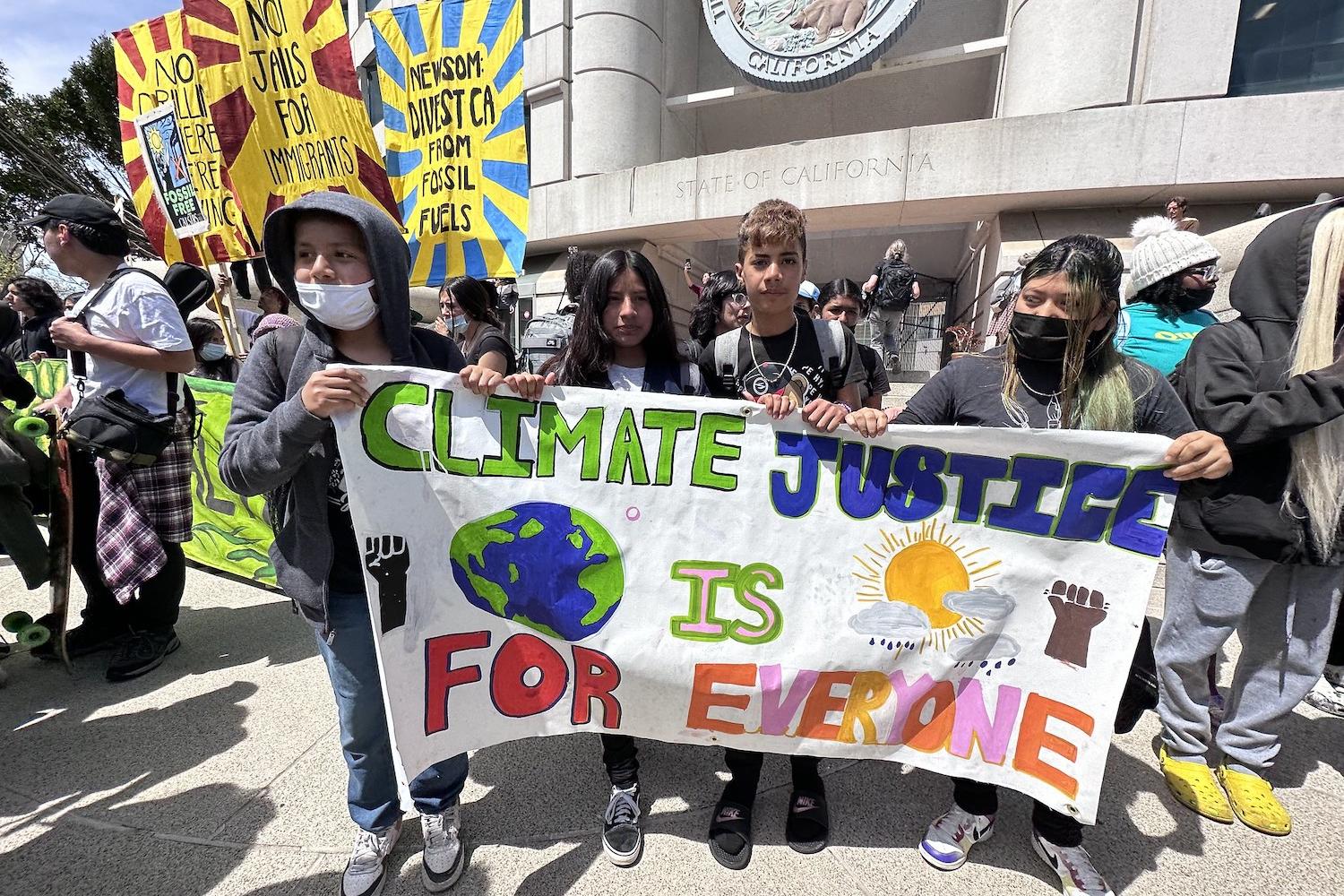
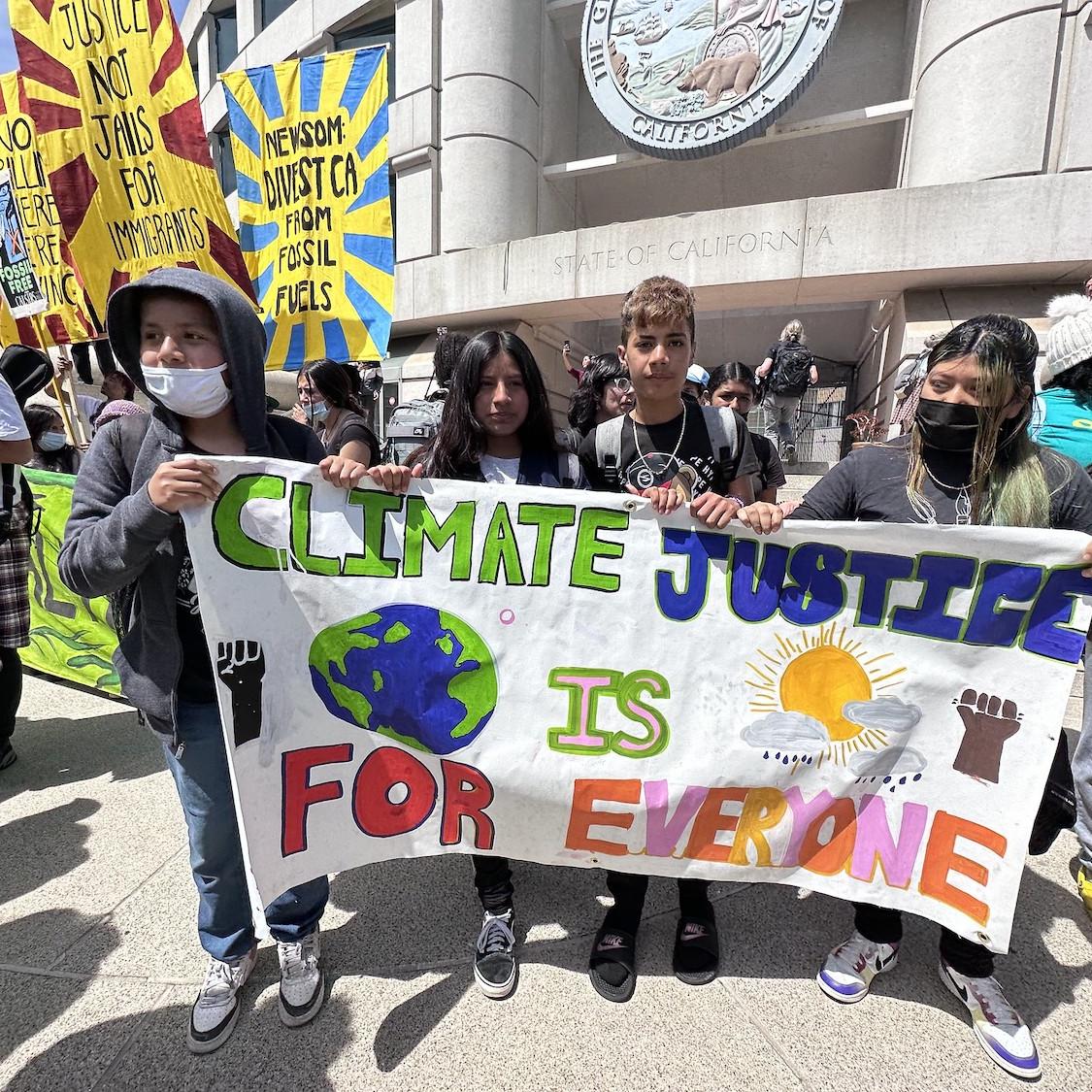
Young people rally in front of the California statehouse in support of climate justice at a Fridays for Future demonstration on April 21, 2023. (Image: Lynn Friedman/Flickr)
Investing in viable solutions to social and environmental problems can turn a profit — and the most lucrative ideas may not come from where you'd expect. That's the philosophy behind Village Capital. The nonprofit launched in 2009 under the tagline "democratizing entrepreneurship." Though it's based in Washington, D.C., its founding mission centers on identifying and supporting innovators outside the big coastal cities that receive the lion's share of venture funding.
Over the past 14 years, Village Capital has supported nearly 1,000 such startups through 45 U.S.-based accelerator programs — which provide funding and mentoring to entrepreneurs with smart ideas to solve big problems.
One of its most recent accelerators squares in on the crucial issue of climate justice, with a call for innovators on the front lines of climate change to submit locally-driven solutions for backing from Village Capital.
What is climate justice?
For the uninitiated, climate justice refers to the imbalanced nature of the real-world impacts caused by climate change: Those who fare the worst amidst natural disasters and sea-level rise tend to be poor and underserved, and as such have contributed least to the greenhouse gas emissions that cause climate change. For context, a billionaire will produce a million times more greenhouse gas emissions in their lifetime than the average person, according to research from Oxfam.
The related cause of environmental justice refers not only to the impacts of climate change, but also the sources of climate-inducing pollution — and where they're located. In the U.S. in particular, years of segregation has created a situation in which communities of color are far more likely to be in the direct vicinity of polluting sites like oil refineries and chemical plants. A bombshell 2021 study from the U.S. Environmental Protection Agency found that people of color are exposed to far higher levels of air pollution during their lifetimes than white people, regardless of income level.
Again, people living in communities that have faced chronic disinvestment for decades are more likely to be poor, and as such consume far fewer of the goods and services that these polluting industries provide. Yet they're still saddled with the impact, whether that's long-term air pollution exposure that can lead to preventable illness, or catastrophic events like leaks and explosions.
Impacted communities have sounded the alarm about environmental and climate justice for decades, but the issues are only more recently gaining attention on the global stage. A global loss and damage fund to help developing countries cope with the impacts of climate change was finally pushed across the finish line at the COP27 climate talks in 2022, although it will be years before it's up and running. U.S. President Joe Biden has also made justice a central pillar of his climate plan, with billions in new investments going toward efforts to reduce emissions and pollution in underserved communities.
Still, government investments have by no means reached the scale of the challenge — making private-sector interventions like Village Capital's accelerator essential to creating the widespread changes needed to cut the problem down to size.
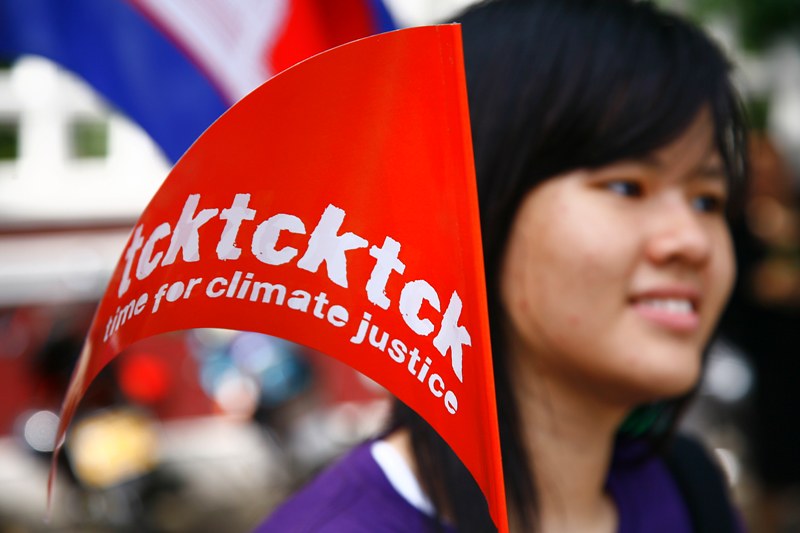
Inside Village Capital's climate justice accelerator
Announced last month, Village Capital's accelerator is seeking early-stage startups that support immigrants, refugees and communities of color on the front lines of climate change in the U.S. In partnership with the WES Mariam Assefa Fund, Village Capital will provide grants and coaching to 10 to 12 startups with promising solutions that help their communities prepare for and adapt to climate impacts. The accelerator is fairly industry-agnostic, with startups across the climate tech, financial tech and property tech spaces encouraged to apply.
"We are looking for impact-driven startups that are solving critical challenges for people and communities who are disproportionately impacted by climate change," Elizabeth Nguyen, economic opportunity practice lead for Village Capital, told TriplePundit. "We’ve been very intentional about identifying the solution types, which thematically fall into: disaster preparedness, public action and civic response, resilient housing and cities, and overall support for immigrants and refugees. Each one of these solution types prioritizes supporting people and communities and enables them the ability to respond to the impact of climate change."
Along with grant funding, the selected entrepreneurs will receive invaluable training on how to further scale their businesses and attract investors, including help with a development plan to chart the course for growth. Through Village Capital's unique peer-selected investment model, the cohort of entrepreneurs will decide which two climate justice solutions will be eligible to receive an additional $100,000 in investments from WES Mariam Assefa, Nguyen said.
"This investment, especially at an early stage, has the potential to change the trajectory of a company, considering many immigrant and refugee founders often don’t have strong social networks or support systems that founders who may have been born in the U.S. have," she explained. "We also can’t stress enough how important social capital, mentorship, and connections are to early-stage companies. Village Capital provides not just training and financial support, but introductions to relevant mentors who are in the refugee and immigrant space and climate tech space. Our support enables our founders to walk away with tangible ways to speak to investors."
Championing locally-driven solutions to climate challenges
Importantly, Village Capital aims to support locally-led solutions driven by the people and organizations that experience climate impacts in their communities firsthand.
"We’ve seen time and again that top-down solutions will not be sustainable or effective because they don’t have a full understanding of the needs in a community," Nguyen said. "Locally-led startups also ensure that the solutions elevate the communities collectively so they are not left behind in the wave of innovation, a challenge that has unfortunately already been reflected in the history of climate tech solutions."
The company's accelerator model is proven to work, with over 150 accelerators supporting more than 1,400 startups globally. Entrepreneurs graduating from Village Capital accelerators raised three times more capital and earned 2.3 times more revenue compared to a control group, according to an impact study commissioned by the company.
The company's separate venture capital fund, VilCap Investments, has invested in over 100 peer-selected startups from across these accelerators — again, with a focus on founders who are often overlooked. Nearly half (46 percent) of startups in the fund are led by women, and 30 percent are led by people of color. A stunning 80 percent are based in states outside New York, California and Massachusetts, which together receive about half of all global VC funding, according to Village Capital.
"By catalyzing locally-led startups and strengthening the ecosystem for these entrepreneurs to succeed, we can create the biggest and most sustainable impact, one that improves and increases services and resources for the communities who need it the most," Nguyen said.
Applications for the accelerator close on May 25, 2023. Full details and eligibility criteria can be found here.
Beyond Trees: Using Blue-Green Algae for Natural Carbon Capture and Sequestration


Fun fact: Several species of flamingo get their pink color from a diet rich in cyanobacteria, but blue-green algae blooms aren't so fun for other wildlife. (Image: Elizabeth Gottwald/Unsplash)
Forestation is an important climate action strategy, but more sophisticated — and potentially more efficient — nature-based alternatives are emerging. One of them involves an environmental two-for-one: capturing carbon by preventing destructive blue-green algae blooms.
Cyanobacteria and algae blooms
Blue-green algae is the common name for cyanobacteria, a type of water-dwelling bacteria that has plant-like photosynthetic abilities.
An over-abundance or “bloom” of cyanobacteria can wreck ecosystems and harm other living things. “A combination of environmental factors such as the presence of nutrients, warm temperatures, and lots of light encourage the natural increase in the numbers of cyanobacteria,” according to the National Oceanic and Atmospheric Administration. In higher concentrations, the toxins produced by some cyanobacteria can damage the liver, nerves, and skin of humans and other creatures, including pets and livestock as well as wildlife.
The U.S. Environmental Protection Agency notes that warmer temperatures and other climate impacts affect the frequency and severity of algae blooms. Blue-green algae blooms in particular are a frequent occurrence in all 50 U.S. states and elsewhere in the world. They mainly occur on inland waters, but they can also happen in the open ocean.
Putting “bad” algae to good use
On the plus side, cyanobacteria are emerging as a clean technology jack-of-all-trades, partly because they are fast-growing, voracious consumers of carbon dioxide. Researchers have tweaked cyanobacteria to produce renewable hydrogen and other biofuels, for example.
Cyanobacteria are also attracting attention for their ability to convert airborne carbon to a solid substance. They have been linked to deposits of the mineral carbonate, a salt of carbonic acid. The “biomineralization” process carried out by cyanobacteria was formerly thought to occur as a result of outside factors. However, 2014 research concluded that some strains are capable of producing carbonate on their own.
In 2020, researchers at the University of Colorado in Boulder put the biomineralization concept to work. They demonstrated that, under the right growing conditions, certain types of cyanobacteria can produce calcium carbonate, which happens to be the main ingredient in cement. The research team tested their method on a growing medium of sand and gelatin. As the cyanobacteria produced calcium carbonate, they mineralized the gelatin and bound the sand into a bio-manufactured brick.

Algae remediation and carbon offsets
Regardless of the potential use cases for cyanobacteria-produced carbonate, algae blooms must be treated and prevented in order to protect aquatic habitats and human health.
BlueGreen Water Technologies is among those developing algaecides that specifically tackle cyanobacteria. Its patented, EPA-approved formula triggers a natural “suicide” response in cyanobacteria, clearing the way for beneficial algae and other aquatic species to take over.
The treatment effectively converts a body of water into a carbon sink, with the dead cyanobacteria locked into sediment for potentially millions of years, according to BlueGreen.
This carbon-sequestering feature could help offset the cost of remediating blue-green algae blooms, if stakeholders could claim carbon credits for the operation. The challenge is to develop a methodology that produces a science-based estimate of the captured carbon.
Scientific verification for cyanobacteria remediation
In March, BlueGreen received approval from the Social Carbon Foundation for its carbon quantification methodology, under the proprietary name Net Blue. Social Carbon manages the trademarked greenhouse gas standard by the same name.
“Net Blue is the first deep water, nature-based climate solution for atmospheric carbon removal that is regulatory approved, scientifically validated and, now, verifiable by industry standards,” BlueGreen asserted in a March announcement.
The company has been remediating cyanobacteria since 2019, for an estimated 3.3 million tons of carbon removal. With the Social Carbon standard in hand, BlueGreen can now market cyanobacteria remediation as a verifiable carbon offset.
According to BlueGreen CEO Eval Harel, the worldwide potential for cyanobacteria remediation offsets adds up to about 115 gigatons of carbon.
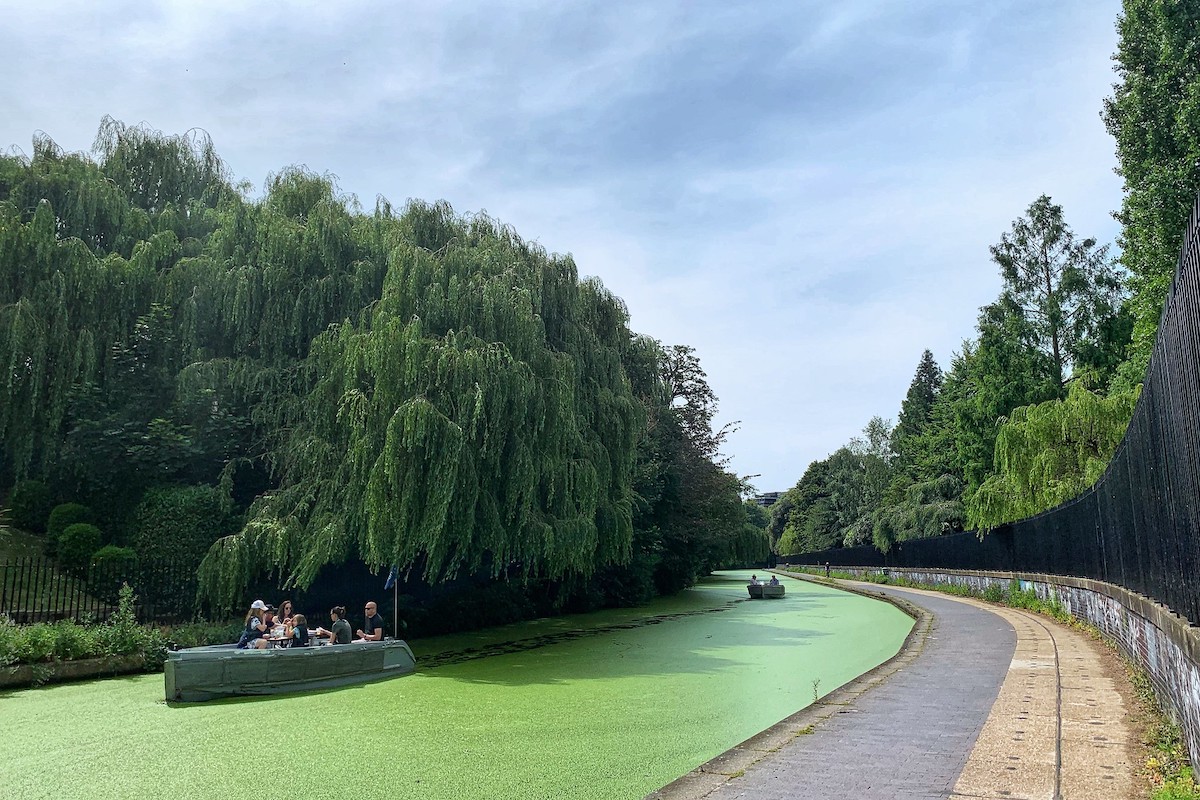
Natural vs. unnatural carbon capture
The emergence of verifiable cyanobacteria remediation credits should help meet the growing demand for carbon credits. The current demand for carbon credits already exceeds the supply, and BlueGreen projects a 15-fold increase in demand for carbon credits by 2030 and a 100-fold increase by 2050.
Cyanobacteria remediation could also help further undercut the case for carbon capture and storage (CCS). CCS has been promoted as an effective pathway for preventing greenhouse gas emissions from coal power plants and other industrial sources. However, the idea of capturing carbon and storing it in underground formations is rapidly losing currency.
BlueGreen offers a fast-acting, scalable carbon capture system that requires no infrastructure. The algaecide can be deployed swiftly to provide additional benefits for local businesses and recreational users, as well as restore biodiversity and protect public health.
In contrast, carbon capture and storage systems offer no such local add-on benefits, and their ability to scale up globally has yet to be proven. In particular, it is difficult to see how CCS infrastructure fits into the rapid decarbonization picture, due to its relatively high costs and long timeline for construction. Typically, CCS systems also require new pipelines to ship captured carbon from the source to a distant storage facility. That raises the threat of environmental impacts related to construction of the pipeline, as well as delays due to public opposition.
The U.S. already has one massive carbon capture failure under its belt, the FutureGen CCS project in Illinois. It kicked off in 2003 with support from the U.S. Department of Energy, intended to provide a showcase for technology to capture and store carbon from a coal power plant. The project was abandoned in 2015.
Since then, new alternatives have emerged in the field of carbon capture, utilization and storage systems (CCUS), which can convert captured carbon into new products that recycle or sequester it, at least temporarily. Recycled-carbon products also help reduce the need to draw virgin petrochemicals from underground.
Fuels, fabrics, perfumes and vodka are among the new recycled-carbon products coming to market, made from carbon collected at industrial sources or drawn from ambient air by CCUS facilities.
The International Energy Agency (IEA) expects CCUS activity to pick up considerably in the coming years, from just 35 systems in operation globally today to an estimated 200 in the pipeline by 2030.
What about the trees?
Despite all the forthcoming activity, IEA does not foresee CCUS playing a leading role in the effort to achieve a net-zero economy.
“Nevertheless… CCUS deployment would remain substantially below what is required" for a net-zero scenario, IEA concluded in a 2022 report. The need remains for a broad expansion of swift, effective decarbonization pathways across the board.
The Social Carbon Foundation is among those working to steer the decarbonization conversation into a more holistic framework that can achieve global progress on a larger scale. Through its Social Carbon standard, the organization advocates for nature-based decarbonization pathways that, like BlueGreen, provide local benefits. The localized nature of this approach requires the standard to be flexible and take political and social elements into account.
“Projects using our standard go beyond carbon, embedding meaningful social, environmental and economic benefits to the projects and their local stakeholders,” Social Carbon's website reads.
“The trademark communicates that emissions reductions result from efforts that benefit and improve living conditions for stakeholders involved in climate change projects, in ways that strengthen their welfare and civic consciousness without degrading their resources base,” it continues.
That reference to resources appears to be a cautionary note against tree-planting programs that focus on commercial timber plantations as a carbon sequestration tool, to the detriment of local habitat. Scientists have also raised concerns about the pace and efficiency of carbon capture through forestation.
Planting trees is likely to continue to hold a place in the carbon market, but companies seeking to burnish their reputation with forestation will need to ensure that their projects adopt a holistic approach that supports local communities.
This Insulation Take-Back Program Cuts Down on Waste in the Building Industry
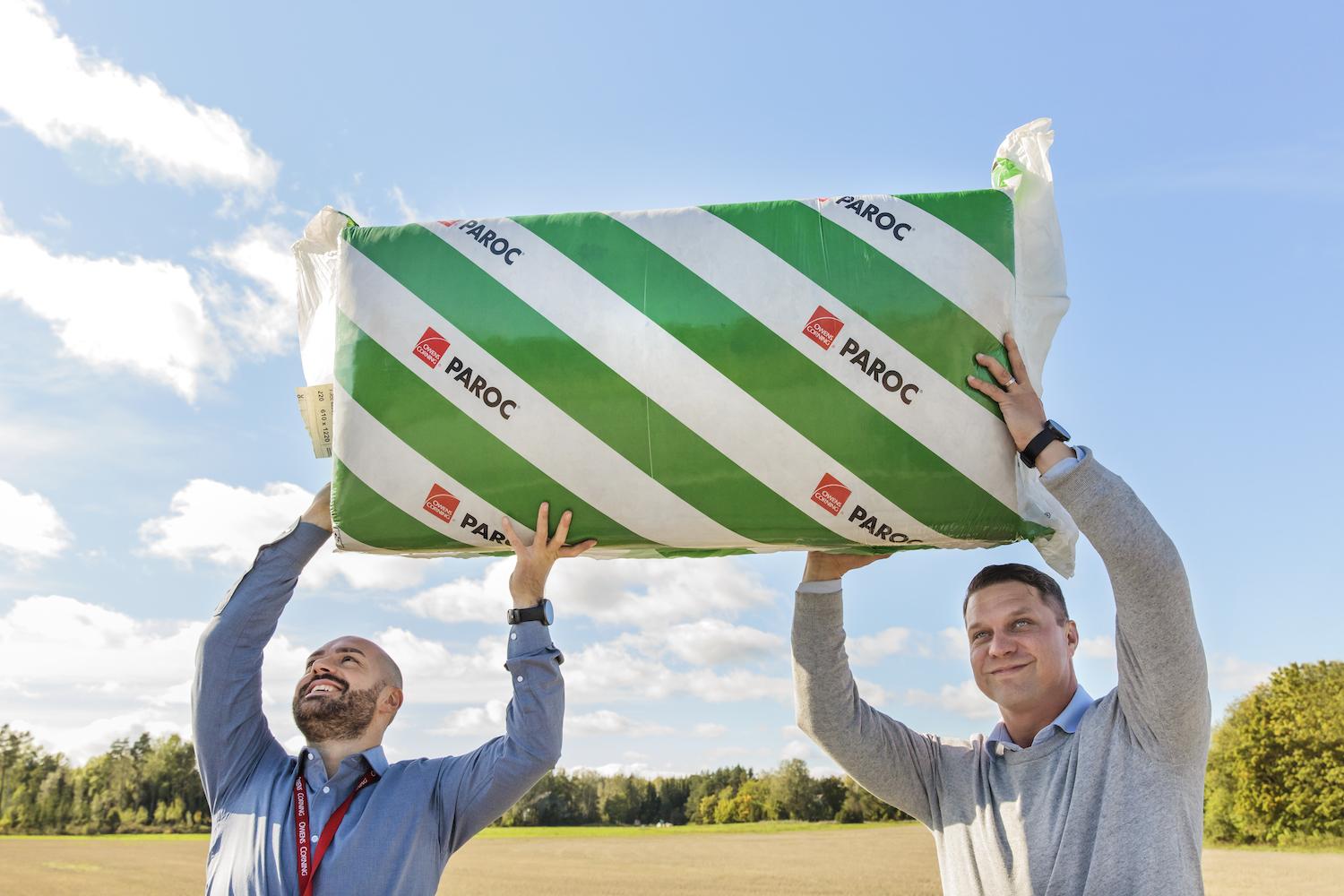
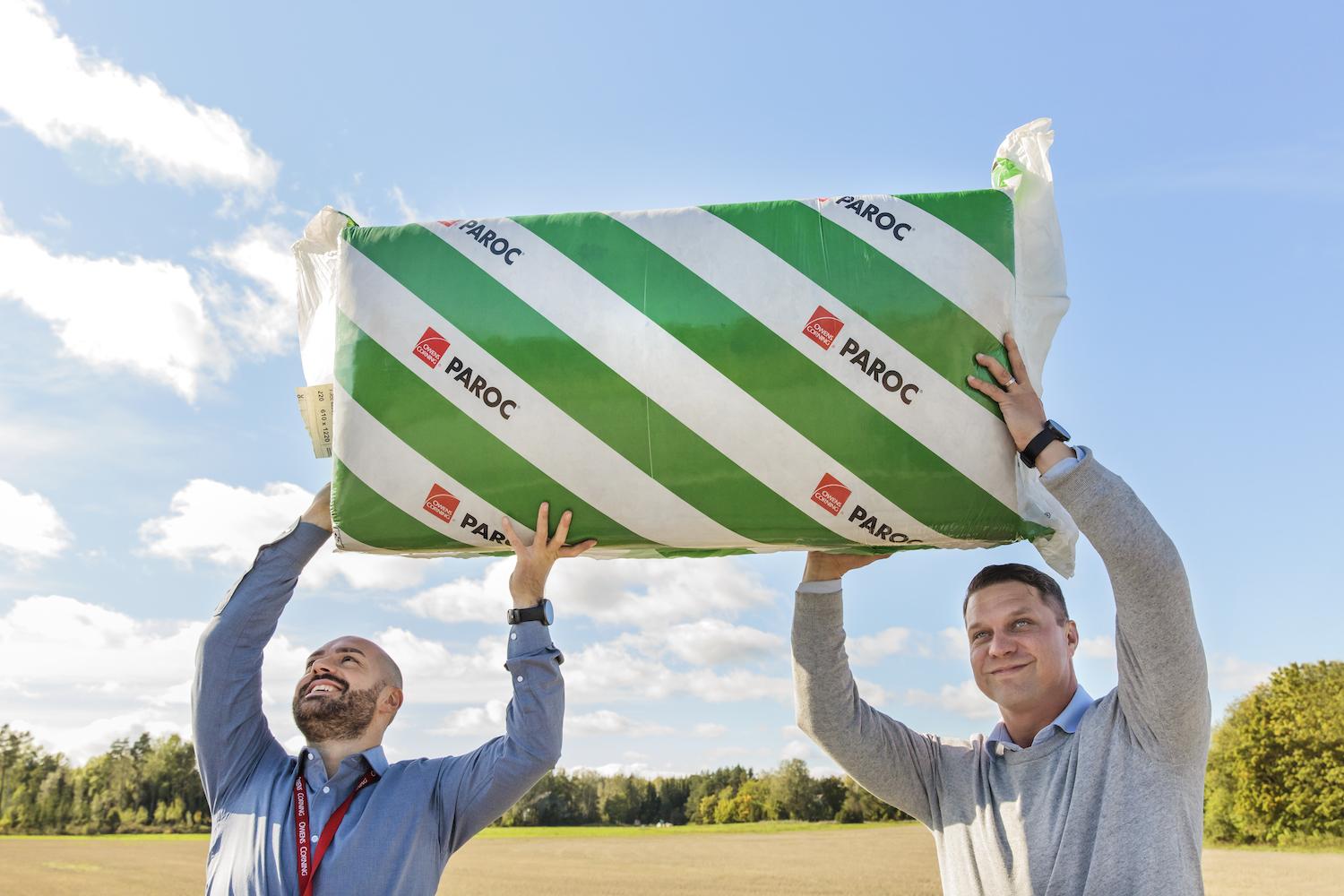
The built environment has a direct impact on the daily lives of virtually every individual and community on the planet. The building industry itself, however, also has significant impacts on the environment. Owens Corning is among the companies in the sector that are looking to minimize their impact and push more sustainable practices forward.
As one of the world’s leading manufacturers of building materials, Owens Corning recognizes the impact its industry can have in the reduction, collection and reuse of waste through circular economy systems. The company’s European insulation brand Paroc, for example, has been running an insulation take-back program known as Rewool for nearly 20 years.
Paroc embraces insulation take-back to reduce waste
Paroc’s stone wool insulation is a natural product that serves as an energy-efficient and fire-safe insulation solution for both new and renovated buildings, as well as heating and air conditioning, marine, offshore, and other industrial applications.
First introduced in Sweden in 1996, the Rewool program allows for collection of Paroc stone wool offcuts to be recycled back into Paroc’s manufacturing operations in an effort to reduce waste and incorporate recycled material into the production cycle.
The program allows Paroc's Finland-based stone wool insulation manufacturing facility to implement circularity principles into its own operations, particularly as the collection of stone wool offcuts and scraps reduces the need for raw materials, turns customer waste into a valuable asset, and gives waste material a new life.
But the program also aids in the important task of helping Paroc customers reach their own sustainability goals, which is of particular importance for the brand’s European clients that are tasked with adhering to and adapting with the principles of the European Green Deal.
“Owens Corning and and its Paroc facilities set our own goal of zero waste to the landfill by 2030, but with the European Green Deal aiming for climate neutrality and a transition to a circular economy by 2050, there are a lot of incentives for our customers to move toward zero waste, as they have the same external pressures through the coming regulation,” said Beatrice Hallén, Owens Corning’s senior sustainability leader for insulation in Europe.

The business case for circularity
While the Rewool program serves as a key example of a sustainable business practice as a means of corporate responsibility, there is also a direct business case to be made for both Paroc and its customers.
Landfills around the world implement fees, known as tipping fees, for every ton of waste. By sending stone wool offcuts and scraps back to Paroc's stone wool plants, customers avoid these fees while also contributing to the beginnings of a more circular economy for insulation. Moreover, sending offcuts back to Paroc plants in lieu of sending them to the landfill increases a building’s score in environmental ratings such as the U.S. Green Building Council’s LEED certification and international BREEAM certification.
Expanding Rewool to more customers
The Rewool program now operates in Sweden and Finland, with plans to expand into new markets in the coming years. A takeback pilot is underway with select customers in Germany, but it is not without its challenges.
“With any new service, there are logistical considerations, and you have to roll out a huge development phase to make it successful,” said Thomas Kayser, Paroc’s European stone wool insulation circular economy lead.
Implementing circularity on a material level is also a tough task, particularly when it comes to ensuring cleanliness and integrity. “The challenge today is really to get the material sorted and clean, but that is a typical challenge in the transition to the circular economy,” Kayser said.
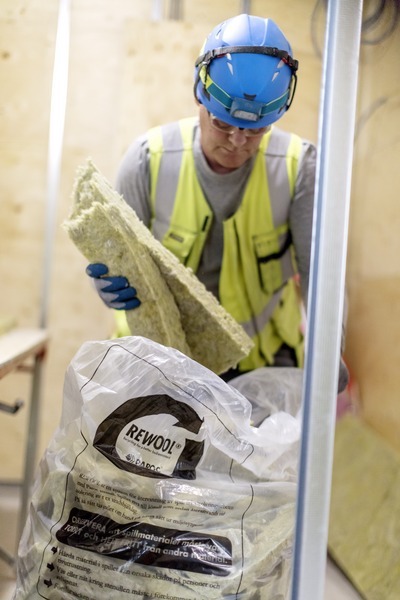
The circular economy as an asset
While there are reasonable logistical and material challenges in expanding the program across Europe, Kayser highlighted that what was once a barrier to expansion is now an impetus for the success of the program, particularly in conjunction with the European Green Deal.
“Originally, generating awareness of the Rewool program with our clients was a challenge. But now that installers are trying to avoid landfill fees, the Rewool recycling service is something they are inquiring about,” he said. “What once was a sell from Paroc is now a frequent request from clients.”
By providing insulation take-back for offcuts, Owens Corning’s stone wool business in Europe gives its customers a practical way to reduce waste, avoid fees and lessen their environmental impact. The Rewool program also fits into Owens Corning's broader strategy to be part of transitioning the building sector to a more circular economy.
“We are working to replace virgin materials in our products, and the Rewool program is a piece of that,” Hallén said. “We are also looking into other industries' waste fractions to see what is suitable for our production, and by doing so, we are able to increase the so-called recycled content, which currently serves as a main indicator of a circular economy [system], particularly in Europe.”
The bottom line: Consistent commitment can change hearts and minds on circularity
The Paroc Rewool program is a prime example of how reducing and reusing waste can support a company’s overall sustainability strategy. But more importantly, the program serves as a catalyst for the industrial and cultural shift toward a circularity mindset.
Programs like Rewool prove that incremental but consistent commitment to the circular economy and material innovation will get people engaged and, slowly but surely, make the lasting changes needed to shift the way the world thinks about waste.
This article series is sponsored by Owens Corning and produced by the TriplePundit editorial team.
Images courtesy of Owens Corning
Why ESG Still Matters During Economic Downturns


The global economic turndown is top-of-mind for business leaders. In the U.S., 59 percent of CEOs anticipate needing to pause or scale back their environmental, social and governance (ESG) efforts as a result, according to a recent survey by KPMG.
However, walking away from ESG right now could be disastrous for business, argues Geetanjli Dhanjal, senior director of business transformation for the consulting firm Yantra.
Scaling back environmental commitments would not only be detrimental to the planet, but it could also hurt the bottom line. “Companies should be committed to ESG and diversity, equity and inclusion (DEI) now more than ever,” Dhanjal told TriplePundit. Pausing these programs to bolster the budget could backfire by eroding consumer perceptions and damaging trust among employees, she warned.
Case in point: The retail sector proves ESG still matters
While certain sectors are more vulnerable to recession than others, retail is one of the highest-risk industries during economic downturns. Still, Dhanjal noted that many of her clients in retail, fashion and apparel are not turning away from ESG to save money. Rather, they are doubling down on their initiatives, from sourcing sustainable materials to ensuring fair pay for workers in their supply chains.
“These clients know that when in an economic downturn, one doesn't just stop investing in ESG," Dhanjal said. "ESG is a long-term strategy and roadmap. During economic downturns, businesses can invest in low-cost sustainability initiatives in order to maintain brand value and give back to the community.”
Further, many sustainability programs come with a cost savings. “When we enable green shipping methods, we reduce our costs, reduce our carbon footprint, and the customer benefits by paying less for shipping," Dhanjal noted as an example.
Investor trust is in jeopardy: Stronger ESG programs and reporting can help
While robust ESG programs can help grow consumer affinity and employee engagement, businesses now face a new problem: waning investor trust.
In KPMG's survey, 3 out of 4 institutional investors said they do not trust companies to meet their ESG and DEI commitments. Dhanjal believes their concerns are valid: Indeed, many companies are not meeting their commitments. But the trust gap also presents investment and growth opportunities for companies that are serious about implementing ESG, she said.
“There are many reasons for distrust," Dhanjal told us. "There are no consistent reporting frameworks. Enterprises may have more standardized reporting methods than small businesses, but they need to report transparently with the proof that they’re doing what they’re saying.”
Businesses and international agencies have also recognized the need for companies to demonstrate proof of their progress through standardized frameworks for sustainability reporting. At the COP26 climate talks in 2021, the United Nations and participating governments established the International Sustainability Standards Board (ISSB) in order to create a standard, global framework.
An evolving regulatory landscape calls for more ESG investment, not less
Dhanjal sees more changes on the horizon for corporate ESG programs. Regulatory changes will make compliance more challenging for companies that do not proactively measure, monitor and report on their sustainability efforts. Time is critical.
“Companies must invest in the tools they can use and the systems to provide them with the data they need to create their long-term strategy," Dhanjal said. "Companies also need the right consultants and partners to guide their programs and initiatives. Your specific company doesn’t need to be experts in ESG, but you can invest in the consultants and tools to guide you.”
Investment in tools to measure sustainability data is increasingly critical for companies that hope to to stay ahead of ESG regulations. The United States and European Union are moving toward making sustainability reporting mandatory for large businesses. That includes climate risk reporting in the near term, with mandatory disclosure of nature-related risk not far off.
The U.S. Securities and Exchange Commission (SEC) in particular is expected to release its long-awaited climate reporting rules this fall. But many businesses are not waiting for the final verdict. In fact, 70 percent of business leaders said they've already begun to disclose their climate-related data in alignment with expected changes from the SEC, according to 2023 polling from PwC and Workiva. Still, 85 percent of those respondents worry their teams don't have the right technology to accurately track and report their sustainability data.
Keeping up with the times requires consistent investment, and pulling back could mean falling behind. "It is not easy to implement systems, transform supply chains and invest in proper tools," Dhanjal said. "Things are changing rapidly while everyone is learning about sustainability at the same time, and that can be a challenge. Making sure we have appropriate tools and clear guidelines is a major challenge for ESG, but this is also our work [as ESG professionals]: to educate.”
Image credit: Miltiadis Fragkidis/Unsplash
Transforming Blight to Boon With Upcycled Sargassum Seaweed


Sargassum seaweed washed up on the beach at Playa del Carmen in Quintana Roo, Mexico. (Image: Thor Tryggvason/Unsplash)
Massive sargassum seaweed blooms have become par for the course in recent years. They’re the result of warming oceans and agricultural nitrogen runoff. As such, the problem is set to only get worse each season.
Fortunately, quite a few startups are working on solutions. One of them is Boston-based Carbonwave. The bio-material processor aims to collect 40,000 tons of sargassum seaweed in 2023. But it's not just about getting the rotting vegetation off of beaches. Once collected, the company is converting the brown algae into bio-stimulants and cosmetic emulsifiers while working to develop more fossil-fuel alternative products.
Sargassum seaweed: From scourge to resource
“We're on a mission to accelerate the circular economy and help with the climate problem,” Carbonwave CEO Geoff Chapin told TriplePundit. “To be able to do both of those things with a naturally occurring resource, it just seems that it's a no-brainer. It’s good for everyone.”
Sargassum seaweed is not only naturally occurring, but it is also integral to ocean health. It provides habitat for marine life, acting as a food source and breeding ground for numerous species. Birds, fish, turtles, shellfish and other sea life all benefit from the stuff, so long as it is in the ocean.
Sargassum, like algae in general, is also responsible for balancing oxygen and carbon dioxide in the world's oceans, Chapin explained. Once it hits reefs and shores, however, the brown algae creates a whole host of problems — including the release of methane emissions as seaweed decomposes in the sun. “The methane release is a huge problem obviously. And when it packs into those bays and rots, it releases arsenic into the water supply," Chapin said. "It kills the fish. And it can suffocate the coral."
Although the blooms become an environmental disaster as they make landfall, there is still value that can come out of it. “Why wouldn't we turn to this resource to help us course-correct on climate gases?” Chapin asked. “As we produce and consume more and more, we have to find alternatives that are aligned with nature, that help heal nature, and that can also be products we use. That's the ultimate goal here: to live sustainably from products that nature gives to us.”
Ultimately, the explosion of sargassum seaweed blooms is among the first tangible effects of the climate crisis, Chapin said. “It’s the ocean trying to heal itself really — from the warmth and the over-eutrophication," he said, referring to the prevalence of algae blooms and dead zones in oceans and waterways. "That's a good process. What we just can't do is let it hit the shores and rot and destroy the ecosystem locally, hurt tourism, jobs, human health and everything else.”
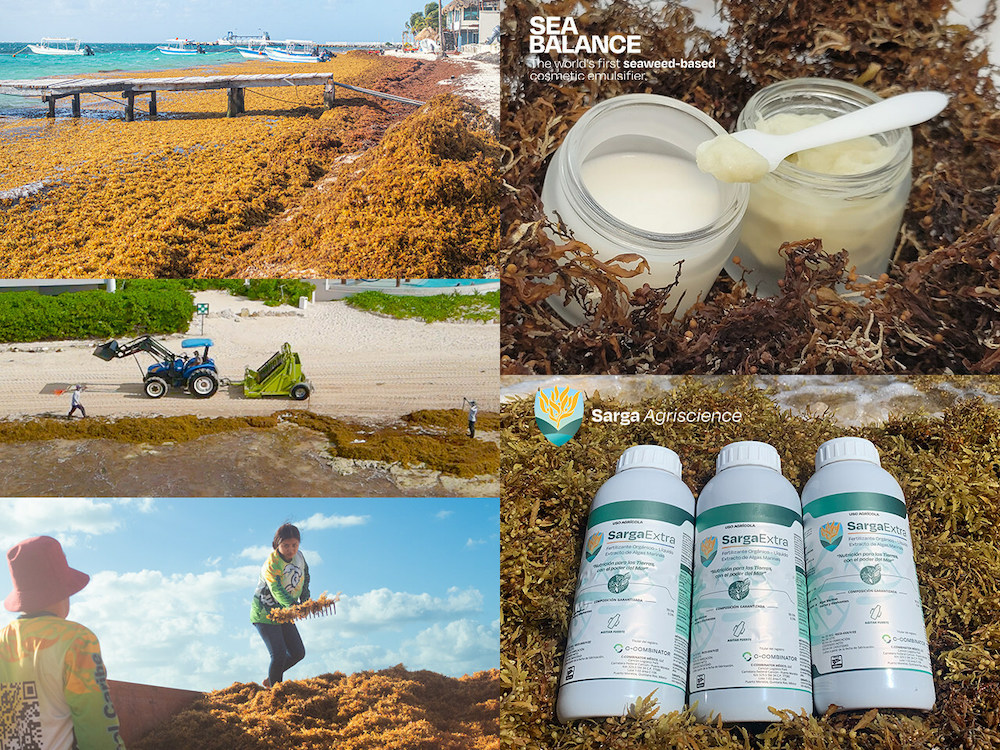
Sargassum-based products
Carbonwave’s products are designed in such a way as to play their own role in reducing climate change and its effects. The company’s biostimulants made from upcycled sargassum seaweed can act as an important part of regenerative agricultural practices, protecting crops from drought and heat. The product — which is sprayed directly on crops — results in sturdier plants and up to 10 percent higher yields by helping them grow more robustly, Chapin explained.
While cosmetics typically contain byproducts of fossil fuels, leading to a heavier carbon footprint and potential health drawbacks, Carbonwave produces cosmetic emulsifiers from sargassum instead. Additionally, the biomaterial maker is working on an alternative leather as well as bio-plastics to replace other traditionally fossil-fuel based products.
Keeping up with demand
One might expect the market uptake for such products to lag — however, that doesn’t appear to be the case. Instead, as far as the emulsifiers are concerned, the demand far outweighs what Carbonwave has the capacity to supply, Chapin said. “Right now, we can't keep up with the demand for emulsifiers in cosmetics,” he said.
Which is why the company is not only expanding its production capacity in Puerto Rico, but it’s also looking to license its proprietary processes that took years to develop. “We don't want to be the [only] one dealing with this massive global problem,” he explained.
Attempting to do so would be unwise, of course. Carbonwave currently collects its raw material on resort beaches in Quintana Roo, on Mexico's Caribbean coast, where Chapin said the bulk of the sargassum seaweed washes up. But, he noted, the smelly tangles of algae have been landing as far north as Ibiza, Spain.
Truly, there is no shortage of work to be done. A concerted effort by a multitude of players will be necessary to make a dent in the problem. Indeed, a variety of products can and are being made, including a seemingly magical compost out of Barbados. Likewise, there is the possibility of capturing sargassum seaweed before it reaches reefs and beaches, as well as plans to sink it into the ocean as a means of carbon capture and storage. All of these potential solutions should be considered and weighed, as diversification will be imperative to solving such a huge problem.
Overall, the key is clearly to treat sargassum as a resource to benefit humanity and not just more trash left to rot or, at best, disposed of. But in order to do so, partnerships as well as huge investments of capital will be necessary. “We would love to hear from any of your readers that are interested in the products at a corporate level,” Chapin said. “We're excited to talk to anyone who is interested.”
The World Has a Rice Problem, But Farmers Can Solve It
Jim Whitaker, a fifth-generation Arkansas rice farmer and proprietor of Whitaker Farms.
Rice is the most commonly eaten food in the world, but conventional rice production has a hefty environmental impact. Growing rice is incredibly water-intensive, and flooded fields are ideal growing conditions for methane-emitting bacteria.
For Jim Whitaker, proprietor of Whitaker Farms and a fifth-generation Arkansas rice farmer, the environmental challenges of conventional rice production were also economic concerns. “I grew up farming,” Whitaker said. “My dad struggled through a historic drought in the ‘80s. I remember coming home on my dad’s birthday, and he had gotten a foreclosure letter from the bank and was going to lose the farm. I was 16 years old, and I could not get that out of my brain.”
When Whitaker and his brother Sam started farming, they began again from scratch with a new plot of land and a loan from the U.S. Farm Service Agency. “We had a beginning farmer FSA loan and the worst piece of ground, but we knew that we had to adapt and change. Doing things the old way was not going to work,” he said.
The brothers decided to add irrigation to their land and level it off, which vastly improves water efficiency and reduces methane emissions. “We got lucky out of the gate,” Whitaker remembered. With a good crop and some income, they were able to further develop their land and rent another farm, which they also leveled.
“We went zero-grade and leveled the rice field completely flat. At the time, it is the gold standard for water conservation and greenhouse gas emissions reduction,” Whitaker explained. Over time, the brothers acquired more and more farmland and transitioned it to regenerative and water-smart practices — growing their operation from 90 acres in 1993 to as many as 9,000 acres today.
Scaling up sustainable rice production
In 2010, Whitaker attended the Rice Leadership Development Program, where he met a rice buyer for Mars, Incorporated. “We became great friends, and that started the journey of Whitaker Farms growing rice for the Ben’s Original brand,” Whitaker said. Today, Whitaker Farms produces over a third of the rice that Mars uses in Ben’s Original Ready-to-Heat pouches in the U.S. and Canada.
Whitaker Farms has also built up its sustainable rice practices over the years and now uses water sensors to monitor in field water levels. This allows them to conserve water through precision irrigation, providing water to fields at just the right times and in just the right amounts, and maximize yield at the same time.
Whitaker also uses a third-party verifier to track and monitor greenhouse gas emissions. The farm specializes in a technique called “alternate wetting and drying,” which means they allow rice fields to dry out before irrigating, a method which is making major waves in an industry that has long relied on perpetually flooded fields.
The wetting and drying method not only saves water and emissions, but it also has financial benefits: By adopting these methods, Whitaker Farms has been able to reduce their fertilizer input by 20 percent and irrigation by 50 percent. They have even been able to sell carbon credits to other companies for reducing emissions through regenerative practices.
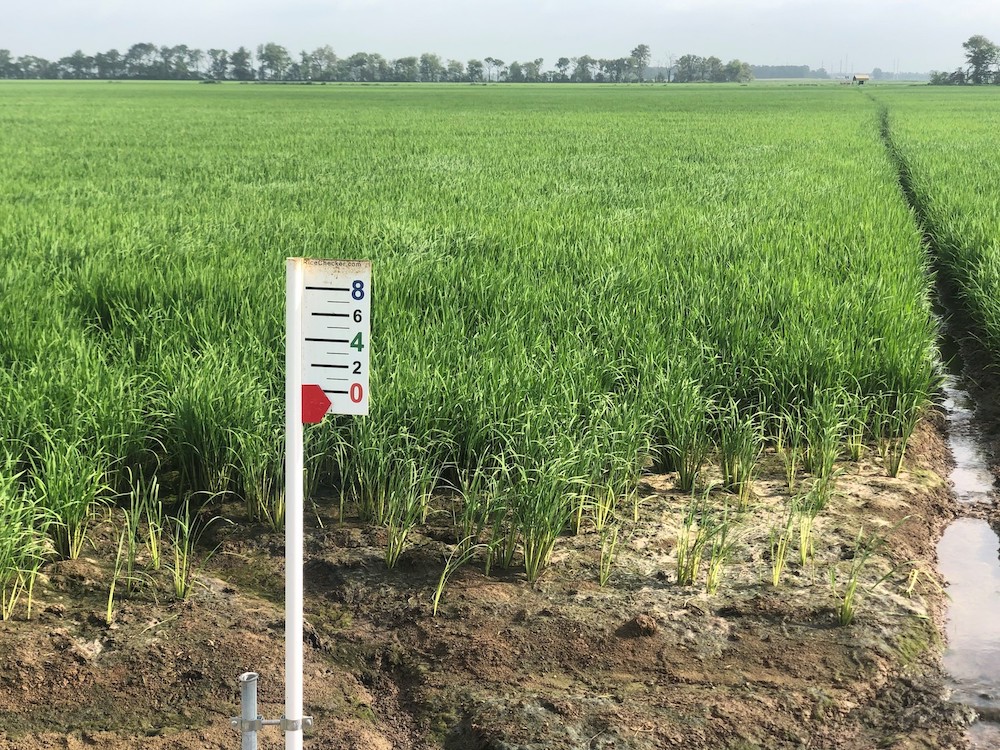
A longstanding supplier relationship opens doors for sustainable rice practices
Whitaker said the relationship with Mars is critical to the farm’s sustainable rice success story. “Rice is a unique market,” he told us. “It is highly controlled globally, and there isn’t a mechanism that allows farmers to trade in the market in the U.S. Our contract with Mars is a good relationship, because it gives me the ability to plan. I know how many acres to work and the budget to work within.”
Mars is committed to sourcing 100 percent of its rice from farmers working toward more sustainable and climate-smart rice production practices, aimed at reducing GHG emissions, reducing unsustainable water use and increasing profitability for farmers. Mars is also a member of the Sustainable Rice Platform (SRP), a global alliance dedicated to helping small farmers grow rice sustainably and increase their resilience to climate change.
Mars is the first company in the consumer goods industry to commit to sourcing 100 percent of its rice from farmers working toward the SRP. It’s also helping other farmers learn about the environmental and economic benefits of wetting and drying rice production.
“We don’t have a lot of choice as farmers,” Whitaker said. “The equipment is getting bigger and more expensive every year. As the farms get bigger, underserved farmers are getting left behind. There is a huge opportunity for the government to provide tax incentives to retiring farmers to transition their farms to new, historically underserved farmers, through a transition period and an apprenticeship. Historically underserved farmers can’t get into regenerative agriculture if they can’t make ends meet. We need to meet them where they are.”
Kristen Campos, VP of corporate affairs at Mars Food North America, said the company is eager to keep this conversation going. “Ben’s Original mission to create opportunities that give everyone a seat at the table,” she said. “So we are looking at different ways and pursuing partnerships to support underserved farmers and bring more people into the farming profession.”
A slow but steady move toward sustainable rice production
Whitaker reflected on his early career, noting that the buzzwords he heard around sustainability planted a seed in his mind. “I could sense the industry was moving in this direction and there was a demand for it,” he said. “People want to do business with folks who are doing the right thing.”
He now realizes that doing the right thing was good for his land as well as his business. Whitaker Farms uses 50 percent less water than the mid-South average and emits 50 percent less methane through alternate wetting and drying, compared to farms of equivalent size using flooding methods. The farm also has 20 percent higher land use efficiency, with yields 20 percent higher than the average for the area.
But Whitaker doesn’t want to stop at the environmental and economic impacts. “From a social standpoint, we are trying to make farming halfway fun,” he said. “It wasn't fun when I grew up. Nobody aspired to be a farmer.” He now strives to make his farm a place where people want to work and foster a more creative and inviting agricultural industry that will attract “sharp young people” looking for a career.
“We hope to train other farmers, and we want to make a difference in their operations,” he concluded. “When it comes to regenerative or climate-smart practices, well, folks need to realize that farmers only get one chance a year to make a mistake. If we plant the wrong variety or put out the wrong fertilizer, we mess up the crop. So, these practices can be scary if they’ve never done it. If we can help people use less water and farm a few more acres economically, then perhaps there is a social benefit to that.”
This article series is sponsored by Mars and produced by the TriplePundit editorial team.
Image courtesy of Mars Incorporated
These Venture Capitalists Are on a Mission to Put Companies on Path to Net Zero From Day One


Can venture capital save the planet? The industry is betting a serious amount of money, to the tune of $70.1 billion, in climate tech startups to prove it can — or at least do its part.
The more muscle behind this goal, the better. Hence the recent launch of the Venture Climate Alliance, a coalition of firms looking to build an industry-wide movement to combat climate change and transition to net-zero emissions.
Some of the world’s largest VC funds, such as Tiger Global, have signed on to the alliance — signaling a shift from traditional VC investment targets like software and financial technology. Twenty-three VC firms across the U.S. and Europe have signed up so far.
Members commit to reaching net-zero emissions for their operations by 2030 and reporting progress transparently. They'll also engage with their portfolio companies to create paths to net zero in the early investment stage and help them to realize those goals.
Venture capital has long played a role in transformative innovation across technology, pharmaceuticals and other industries. So, it makes sense for the industry to embrace a role in scaling up climate tech as part of the solution to reduce greenhouse gas emissions.
High energy prices and government support drive momentum for climate tech
It doesn’t hurt that a jump in energy prices is driving more money to climate tech. Green energy technologies are reaching the point where they are cheaper and better performing than their fossil fuel incumbents. It’s no wonder, then, that funding for startups focused on clean energy and reducing fossil fuel use rose 4 percent from 2021 to 2022, according to BloombergNEF.
Government support is also increasing with policies like the U.S. Inflation Reduction Act and the EU Green Deal Industrial Plan. Across the globe, public and private investments in climate tech totaled $1.1 trillion in 2022, according to a Bloomberg analysis.
"Net zero for thee but not for me is no longer a workable solution,” Daniel Firger, co-founder of the Venture Climate Alliance, said in a statement. “If we're serious about moving the entire world economy into alignment with a pathway to net-zero emissions, we must consider the critical role that private markets play in that journey."
Early-stage innovation can help legacy industries get to net-zero faster
VC investors are the linchpin between capital markets and early-stage innovation, with the opportunity to help companies move from initial development to commercialization and scale.
The alliance wants to bridge the gap between the hundreds of net-zero commitments in public markets and early-stage innovation from startups, which can help legacy industries decarbonize at a lower cost with new products and processes, Alexandra Harbour, a co-founder of the Alliance, said in a press announcement.
Marrying established companies with startups is a proven path to achieving greater innovation for legacy industries while giving newcomers a leg up, as TriplePundit recently reported.
Yet the methodologies, tools, and data to track climate impacts of early-stage investments are either nonexistent or inaccessible, the Alliance attests. That’s why its members want to develop best practices to collect, interpret and report this data and share what they learn with the industry.
Image credit: Scott Webb/Pexels
Circular Design is Key to The North Face’s Strategy to Make Clothing More Sustainable
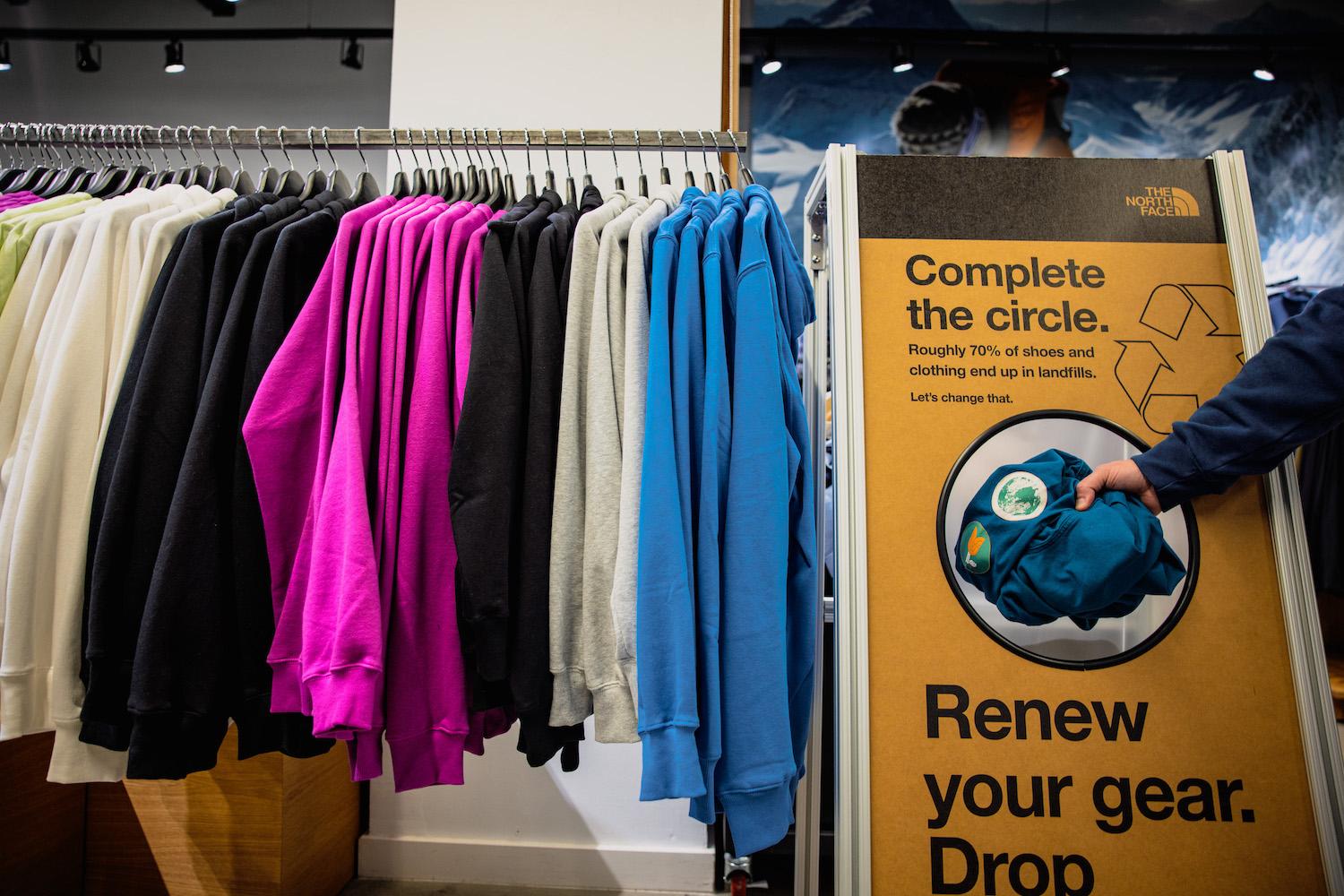
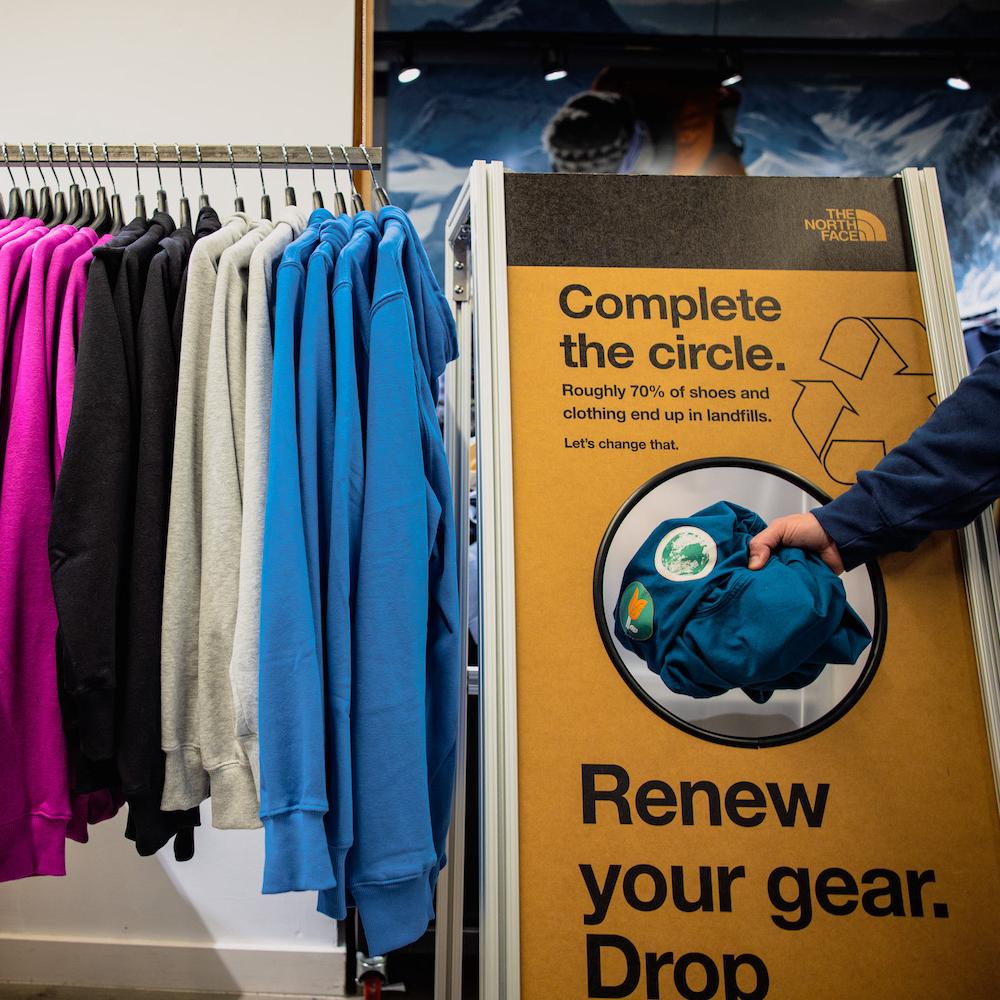
The apparel industry rightly comes in for criticism for being unsustainable. The so-called “fast-fashion” trend means cheap clothing is designed for short-term seasonal use with subsequent disposal in a very rapid cradle-to-grave cycle.
Between 2000 and 2014, clothing got cheaper, and fast fashion became the norm. The average person purchased 60 percent more clothing than they did in the 1990s and held onto it for half as long, according to an analysis from McKinsey Sustainability. This rapid clothing production requires a lot of energy — more than what the aviation and shipping sectors use combined, according to the U.N. Framework Convention on Climate Change. As a result, the fashion industry is responsible for almost 10 percent of global greenhouse gas emissions.
The outdoor recreation products company the North Face is one of a growing number of apparel makers aiming to reduce the damaging effects of the clothing industry by changing the way they design their products.
TriplePundit spoke to Carol Shu, senior manager of global sustainability at the North Face, about the company’s efforts to reduce environmental impact.
Designing products that last
The company’s sustainability efforts center around circular design — a process that considers durability, ease of recycling, minimizing waste and use of responsibly sourced materials. For the North Face, the first step is ensuring product longevity.
“We take materials selection very seriously,” Shu said. “Materials are selected for performance and durability to extend the life of the products, and to keep them in use.”
Extending product life is part of the the North Face’s DNA. The company introduced a limited lifetime warranty in 1968, shortly after its founding. Three years later, it opened a department to repair customers’ garments at the original factory in Berkeley, California.
Fast forward to the present: The North Face repaired more than 41,000 items in the last fiscal quarter. On average, the products repaired are about seven years old, Shu said. “We always want to think about next best use. If someone has something that is broken, we want them to send it in for repair first.”
When customers inevitably outgrow their gear, some of it is refurbished and re-sold, and others are donated.
Circular design: Starting with end-of-use in mind
The North Face is rethinking the entire design process to be more sustainable when an item finally reaches the end of its useful life. “With circular design coming into play, the products are unique because it’s the first time we’ve intentionally designed them with end-of-life in mind,” Shu said.
This process starts with avoiding materials that cannot be recycled. Blended fabrics composed of multiple materials, for example, cannot be reprocessed and are therefore destined for landfills.
The North Face’s circular design product line uses mono-material fabrics that are easy to recycle. An important fabric suitable for a second life is polyester. The company’s industry partners deconstruct old garments and rework the material back into yarn that can be spun into new clothing.
To recycle polyester efficiently, designers must consider how to make the products easy to take apart. They think about how to manage trims like zippers and buttons. Where possible, trims should be 100 percent polyester, Shu said. When that’s not an option, designers focus on making the trims as easy to remove as possible.

The company runs tests with its recycling partners to make sure the design considerations for end-of-life deconstruction work as intended. “The best designed style for circularity took about five seconds to disassemble,” Shu said. “This is very important because, in recycling, everything has to be so fast to make the economics of it work.”
The circular design focus also applies to other materials like cotton and cotton-polyester blends. When recovered, the fibers are sent to manufacturing sites for reuse, predominantly in Asia and Central America where most apparel manufacturing takes place.
These recycled materials won’t necessarily be used for new pieces from the North Face, though there may be opportunities for that in the future, Shu said. But the materials are recycled and reused, thereby reducing waste streams, which globally constitute tens of millions of metric tons of discarded clothing every year.
For customers, the process is easy. They simply bring back an item purchased from the North Face to one of the company’s retail stores when they are done with it. If they are an XPLR Pass member, they receive a shopping credit.
The challenges to going fully circular
In a perfect world, everything the company sells could be recycled under the circular design process, but challenges remain. Some of its technical gear is difficult to design for circularity, Shu said. This includes items with waterproof layers, lots of pockets and multiple materials that are essential for functionality.
The demand for recycling is also hard to predict. But the North Face wants to avoid merely being an intermediary for directing material to landfill, Shu said, so the company is establishing regional recycling partners to ensure it has the capacity to recycle as much returned product as possible.
“We sell products globally,” she said. “So we’re setting up circularity infrastructure in North America and Europe, because we don’t want to be shipping customers' products to other regions for recycling.”
Expansion is coming
The North Face continues to expand its line of circular design products. Twenty products were available in the line last fall. By fall 2023, the company plans to triple the number of circular styles.
The company will continue its focus on converting the materials it uses to lower-impact sources, Shu said. “We have a goal of converting 100 percent of our most commonly used materials — polyester, nylon and cotton — to either recycled, regenerative-organic, responsibly-sourced or renewable sources by 2025,” she explained.
The North Face will launch the first product in its “climate conscious cotton” line this spring. The cotton in the line comes from farmers in the U.S. who use regenerative farming practices — like crop rotation and composting — which improve soil health and enhance carbon sequestration.
It’s a win-win, Shu said. “Farmers want to reduce their reliance on synthetic inputs too.”
Images courtesy of the North Face